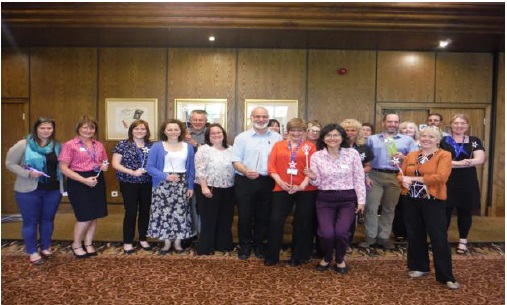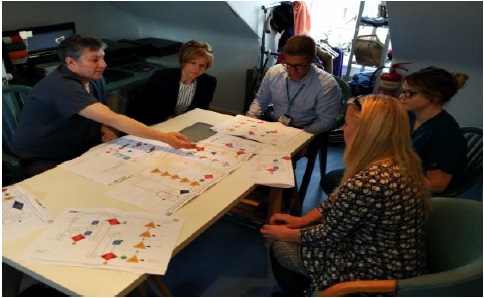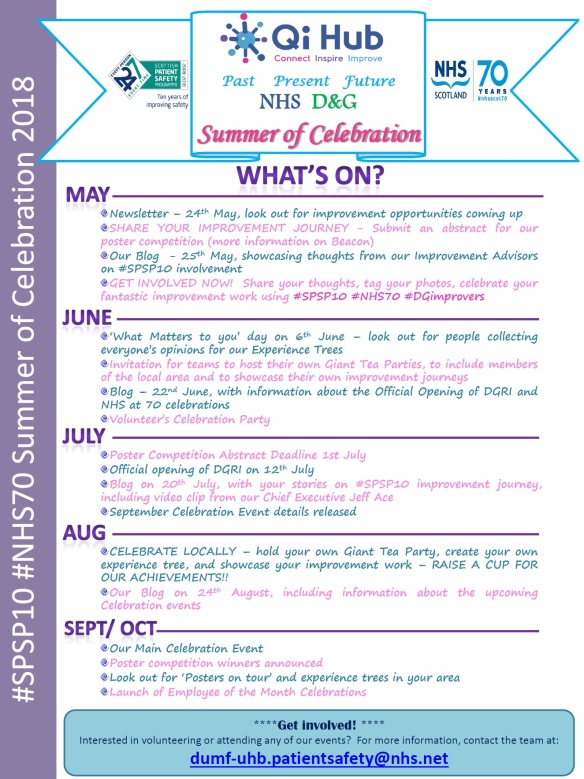Well, that’s been an interesting few months, hasn’t it!! We all watched with fascination as Covid spread across the Globe – China first then Italy and Spain – before it hit our shores and started creeping towards Dumfries and Galloway. Everything changed. We were told to stay at home, avoid loved ones we didn’t live with, only go out if necessary and our work was transformed. Many people had to ‘Shield’ at home and could no longer work. Those still coming in found their working day turned on its head; perhaps completely new duties or sitting in front of a screen all day. But there was one thing I am pretty sure was felt by everyone; fear.
I was terrified. Terrified of how many people were going to get sick, terrified of how many may die, terrified for our frontline staff who were putting their lives at risk. I was also terrified for my own family and loved ones and, whilst this may sound selfish, I was terrified that I would fail in my job. This felt like a big test of leadership. Was I up to the task? Was D&G at risk because I was about to fail. Many sleepless nights followed.
However it all looks different now. We have survived the first peak of Covid and, in general, we have gotten off fairly lightly. Our colleagues in the Critical Care Unit and Care Homes may disagree as those two areas have experienced a significant impact from the disease but, as a region, the numbers were nowhere near what we expected and whilst this may be down to our rurality it also reflects how all of us have adhered to social distancing and isolation and stopped the spread.
So what happens now? Lockdown restrictions will start to ease, people will be out an about and there is the strong possibility of a second wave. However there is no doubt that we are much more prepared for that and have systems in place to deal with it should it come. But social distancing is here for some time and we all need to think how we are going to deliver our services for the people of D&G in this uncertain future.
Things have changed and one message I would like to share today is that we cannot go back to what we had before. It quite simply wasn’t working and if we have demonstrated anything in the past 3 months it is that we can deliver healthcare in 2020 in a very different and more efficient way. We don’t need face to face consultations all the time, we don’t need to admit so many people to hospital, we don’t need lots of different steps before a patient interacts with the professional they need to.
There was one other noticeable change when all this kicked off; we all pulled together like never before. Many petty differences which had prevented progress vanished. People reached out to help each other (virtually or 2m apart, of course!) and it was obvious that we genuinely cared about our colleagues. There was really no need to use the phrase ‘We are all in this together’ because we all inherently knew that was the case.
So while the dust settles and we look around at the ‘New Normal’ let us not go back to what we did before. Let us embrace new ways of working and talk to our colleagues about how we do it together. Let us do the right thing for our population.
“A crisis can create an opportunity to learn and build a better way forward. The system that will emerge on the other side of the crisis is shaped by those leaders who are able to harness the potential in the moment and galvanise others to act.”
John Sturrock 2019

Ken Donaldson is Executive Board Medical Director for NHS Dumfries and Galloway
With thanks to Charles Mackesy for the image.

 financial constraint. We started touring the region this week, meeting with teams to discuss these issues and ask them for their thoughts and ideas. It has been energising to hear from you all, there are lots of really good and simple ideas as to how we can change, but it is also apparent that there are many significant obstacles that it will take time to overcome.
financial constraint. We started touring the region this week, meeting with teams to discuss these issues and ask them for their thoughts and ideas. It has been energising to hear from you all, there are lots of really good and simple ideas as to how we can change, but it is also apparent that there are many significant obstacles that it will take time to overcome. Two words stick out to me, Innovation and Transformation. Both are necessary, both are hard, especially when we are busy, but both can be fun if we work together and support each other to deliver them. Done well they can make our lives less busy and our patients care safer and more person centred. But how can we achieve this? I know many people reading this will be thinking ‘Well, fill all our vacant posts and that will solve the problem’ and they may be right, but we know that is not easy and, whilst we cannot take our eye off the recruitment challenge, we need to do something else.
Two words stick out to me, Innovation and Transformation. Both are necessary, both are hard, especially when we are busy, but both can be fun if we work together and support each other to deliver them. Done well they can make our lives less busy and our patients care safer and more person centred. But how can we achieve this? I know many people reading this will be thinking ‘Well, fill all our vacant posts and that will solve the problem’ and they may be right, but we know that is not easy and, whilst we cannot take our eye off the recruitment challenge, we need to do something else. To create a compassionate culture, one in which we can thrive and transform our services, then we all need to demonstrate these simple behaviours. I urge you to ‘Hold the Mirror up’ to yourself and consider your behaviours not others. What can you do to improve your service, not what others can do to improve theirs.
To create a compassionate culture, one in which we can thrive and transform our services, then we all need to demonstrate these simple behaviours. I urge you to ‘Hold the Mirror up’ to yourself and consider your behaviours not others. What can you do to improve your service, not what others can do to improve theirs.







 The QI Hub is a creative space where you can connect with others throughout health & social care, people with a passion to make a difference. Thinking space, away from the hustle & bustle that is daily life!! Come and find a supportive network of colleagues, share experiences and learning. Choose from a library of resources and practical tools to help structure your improvement projects and explore development and coaching opportunities.
The QI Hub is a creative space where you can connect with others throughout health & social care, people with a passion to make a difference. Thinking space, away from the hustle & bustle that is daily life!! Come and find a supportive network of colleagues, share experiences and learning. Choose from a library of resources and practical tools to help structure your improvement projects and explore development and coaching opportunities. Building capability and capacity to lead improvement is vital, it empowers people and teams to own change; one resource available is a locally delivered Scottish Improvement Skills Programme. To illustrate how this is already having impact Wendy Chambers, who has recently graduated from Cohort 1, shares her reflections.
Building capability and capacity to lead improvement is vital, it empowers people and teams to own change; one resource available is a locally delivered Scottish Improvement Skills Programme. To illustrate how this is already having impact Wendy Chambers, who has recently graduated from Cohort 1, shares her reflections. Being surrounded by similar and like minded people; learning from each other, sharing ideas, both the things that go well and the things that fail – I’ve come to appreciate that this support is essential to the process of implementing and testing change ideas. Because when I go back out into the real world, with all its pressures and realities, the natives won’t necessarily be as welcoming or receptive to my “bright ideas” and things won’t feel as cosy. So now I won’t be alone, I’ve found my tribe, I’ve found support.
Being surrounded by similar and like minded people; learning from each other, sharing ideas, both the things that go well and the things that fail – I’ve come to appreciate that this support is essential to the process of implementing and testing change ideas. Because when I go back out into the real world, with all its pressures and realities, the natives won’t necessarily be as welcoming or receptive to my “bright ideas” and things won’t feel as cosy. So now I won’t be alone, I’ve found my tribe, I’ve found support.


 Now, give yourself some credit – think of an example where you did something that was appreciated. Write it down and remember it. If you’re having a team meeting, take time to share examples of things that the team did, that were appreciated by others. Sharing these examples will give you a bank of ideas about simple things that matter to other people. And it also gives you something to fall back on, if times are tough.
Now, give yourself some credit – think of an example where you did something that was appreciated. Write it down and remember it. If you’re having a team meeting, take time to share examples of things that the team did, that were appreciated by others. Sharing these examples will give you a bank of ideas about simple things that matter to other people. And it also gives you something to fall back on, if times are tough. Will any of this change the world? Not on its own, of course. But you could change one person’s world, by a simple act of kindness, or listening, or a word of thanks. You can make difference!
Will any of this change the world? Not on its own, of course. But you could change one person’s world, by a simple act of kindness, or listening, or a word of thanks. You can make difference!


















